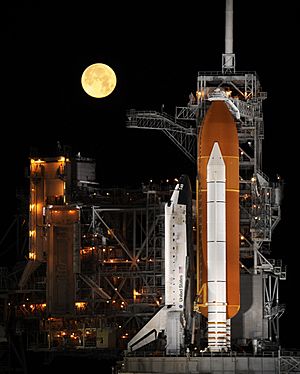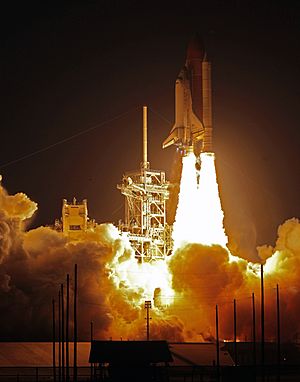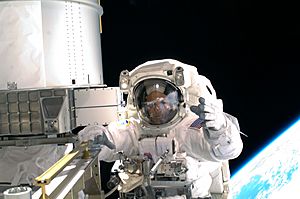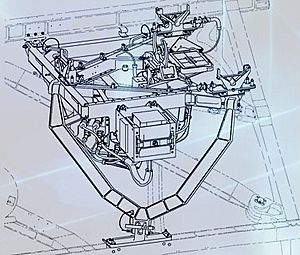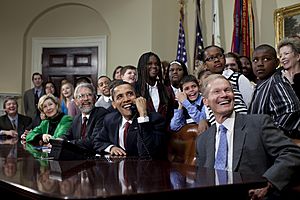STS-119 facts for kids

The International Space Station (ISS) after Discovery left, with its new solar arrays installed.
|
|
| Mission type | ISS assembly |
|---|---|
| Operator | NASA |
| Mission duration | 12 days, 19 hours, 29 minutes, 33 seconds |
| Orbits completed | 202 |
| Spacecraft properties | |
| Spacecraft | Space Shuttle Discovery |
| Launch mass | 120,859 kilograms (266,448 lb) |
| Landing mass | 91,166 kilograms (200,986 lb) |
| Crew | |
| Crew size | 7 |
| Members |
|
| Launching | |
| Landing | |
| Start of mission | |
| Launch date | 15 March 2009, 23:43 UTC |
| Launch site | Kennedy LC-39A |
| End of mission | |
| Landing date | 28 March 2009, 19:13 UTC |
| Landing site | Kennedy SLF Runway 15 |
| Orbital parameters | |
| Reference system | Geocentric |
| Regime | Low Earth |
| Perigee | 385 kilometres (208 nmi) |
| Apogee | 402 kilometres (217 nmi) |
| Inclination | 51.6 degrees |
| Period | 91.6 minutes |
| Docking with ISS | |
| Docking port | PMA-2 (Harmony forward) |
| Docking date | 17 March 2009, 21:20 UTC |
| Undocking date | 25 March 2009, 19:53 UTC |
| Time docked | 7 days, 22 hours, 33 minutes |
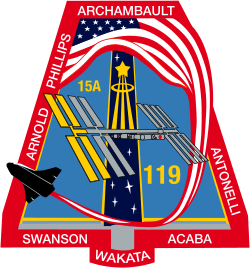  Front row (L–R) Antonelli, Archambault. Back row (L–R) Acaba, Phillips, Swanson, Arnold and Wakata. |
|
STS-119 was a Space Shuttle mission to the International Space Station (ISS) in March 2009. The space shuttle Discovery carried a very important part to the ISS. This part was the fourth and final set of solar arrays and batteries. These arrays help power the station.
The mission launched on March 15, 2009. Discovery landed safely on March 28, 2009. This mission was a big step in finishing the construction of the ISS.
Contents
- Meet the Astronauts: The STS-119 Crew
- What Did STS-119 Carry?
- Important Facts About the Mission
- Getting Ready for Launch
- Mission Timeline: A Day-by-Day Look
- March 15: Launch Day!
- March 16: Checking the Shuttle
- March 17: Hello, Space Station!
- March 18: Moving the Big Piece
- March 19: First Spacewalk and Solar Array Installation
- March 20: Unfurling the Solar Wings
- March 21: Second Spacewalk
- March 22: Dodging Space Junk
- March 23: Third Spacewalk
- March 24: A Call from the President
- March 25: Saying Goodbye to the ISS
- March 26: Checking for Damage
- March 27: Getting Ready to Land
- March 28: Back on Earth!
- Spacewalks (EVAs)
- Wake-Up Calls in Space
- Images for kids
- See also
Meet the Astronauts: The STS-119 Crew
The STS-119 mission had a team of seven astronauts. They were all very important for the mission's success.
- Commander: Lee J. Archambault (his second and last flight)
- Pilot: Dominic A. "Tony" Antonelli (his first flight)
- Mission Specialist 1: Joseph M. Acaba (his first flight)
- Mission Specialist 2: Steven R. Swanson (his second flight)
- Mission Specialist 3: Richard R. Arnold (his first flight)
- Mission Specialist 4: John L. Phillips (his third and last flight)
- Mission Specialist 5: Koichi Wakata (his third flight, he stayed on the ISS)
Sandra H. Magnus was already on the ISS. She returned to Earth with the STS-119 crew.
What Did STS-119 Carry?
The main goal of STS-119 was to deliver the S6 solar arrays to the space station. These solar arrays are like giant wings that collect sunlight and turn it into electricity. They were the last major pieces needed to complete the station's main power system.
The mission also carried some science experiments. These included tests about how the shuttle's exhaust affects the upper atmosphere. Another experiment looked at how heat moves on the shuttle's surface during reentry.
| What it was | How much it weighed |
|---|---|
| Orbiter Docking System (for connecting to ISS) and spacesuits | 1800 kg + 260 kg |
| Shuttle Power Distribution Unit | 17 kg |
| S6 Truss (the main solar array part) | 14088 kg |
| Orbiter Boom Sensor System (a robotic arm extension for checking the shuttle) | 382 kg |
| Canadarm 202 (another robotic arm) | 410 kg |
| Total weight of cargo: | 16957 kg |
Important Facts About the Mission
STS-119 was a special mission for many reasons:
- It was the 156th time NASA sent people into space.
- It was the 125th flight of a space shuttle.
- It was the 36th flight for the space shuttle Discovery.
- It was the 100th mission after the Challenger accident.
- It was the 12th mission after the Columbia accident.
- It was the 28th shuttle mission to the International Space Station.
Getting Ready for Launch
The space shuttle Discovery was moved to its launch pad on January 14, 2009. This was Launch Pad 39A at Kennedy Space Center. The S6 truss, which held the solar arrays, was already there.
Before the launch, engineers found a problem with some valves on the shuttle. These valves help control the flow of hydrogen fuel to the engines. Because of this, the launch was delayed. Engineers replaced the valves to make sure everything was safe.
The launch was first set for March 11, 2009. But it was delayed again because of a small leak in a hydrogen vent line. Finally, on March 15, 2009, Discovery successfully lifted off!
Mission Timeline: A Day-by-Day Look
March 15: Launch Day!
Discovery launched right on time at 7:43 PM EDT. The launch looked perfect, with no major issues. After reaching orbit, the crew opened the shuttle's cargo bay doors. They also got the robotic arm ready.
A Bat on the Tank?
During the countdown, a small bat was seen clinging to the shuttle's external fuel tank. People thought it would fly away when the shuttle launched. But it stayed! Sadly, the bat probably didn't survive the powerful rocket exhaust. Experts later thought the bat might have had a broken wing.
March 16: Checking the Shuttle
On the second day, the crew inspected Discovery's heat shield. This shield protects the shuttle from extreme heat when it returns to Earth. They used the shuttle's robotic arm with special cameras and sensors. The images were sent to experts on the ground to check for any damage. Everything looked good!
March 17: Hello, Space Station!
The crew prepared to meet and connect with the International Space Station. Before docking, Discovery did a special flip. This allowed the ISS crew to take pictures of the shuttle's underside.
Discovery successfully docked with the ISS at 5:20 PM UTC. After checking for leaks, the hatches between the shuttle and station were opened. The astronauts greeted each other. Then, they started moving important items between the two spacecraft. This included swapping seat liners for astronauts Koichi Wakata and Sandra Magnus. This meant Wakata officially joined the ISS crew, and Magnus joined the shuttle crew.
March 18: Moving the Big Piece
The crews worked together to move the S6 truss, which held the new solar arrays, out of Discovery's cargo bay. This was a tricky job! The station's robotic arm and the shuttle's robotic arm had to pass the truss back and forth. This was done to get it into the right position for installation.
Two astronauts, Steven Swanson and Richard Arnold, spent the night in the Quest airlock. They slept in a special low-nitrogen atmosphere. This helps spacewalkers avoid getting sick from pressure changes.
March 19: First Spacewalk and Solar Array Installation
Astronauts Swanson and Arnold went outside the station for the first spacewalk. They started installing the S6 truss segment. They bolted it into place and connected power and data cables. They also removed covers and prepared the solar arrays for deployment. The spacewalk lasted over 6 hours.
Because the shuttle looked so good after launch, mission managers decided to deploy the solar arrays earlier than planned. This was a smart move in case any problems came up that needed another spacewalk.
March 20: Unfurling the Solar Wings
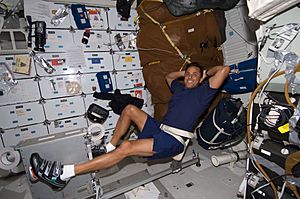
This was a big day! The crews began unfolding the new solar arrays on the S6 truss. The station was moved to stay in constant sunlight. This helped warm up the arrays and prevent them from sticking.
The first array unfolded smoothly. The second one had been packed for eight years, so it was a bit sticky. But it also fully opened! With these new arrays, the station's power doubled. The total area of the station's solar arrays is now almost one acre!
March 21: Second Spacewalk
Swanson and Acaba performed the second spacewalk. They prepared a work site for a future mission. They also installed a new GPS antenna on the Japanese Kibo laboratory. They worked on some radiator panels and reconfigured power connectors. They also had a bit of trouble with a cargo attachment system, but they secured it safely. This spacewalk lasted 6 hours and 30 minutes.
March 22: Dodging Space Junk
The shuttle and station had to move to avoid a piece of space debris. This shows how important it is to track objects in orbit.
March 23: Third Spacewalk
Acaba and Arnold completed the third spacewalk. They moved a cart for crew equipment and lubricated parts of the station's robotic arm. They tried again to deploy the cargo carrier system from the previous spacewalk, but it was still stuck. They secured it for later repair. This spacewalk lasted almost 6 and a half hours.
March 24: A Call from the President
All the astronauts on Discovery and the ISS gathered to talk with the President of the United States, Barack Obama. They also spoke with members of Congress and schoolchildren.
March 25: Saying Goodbye to the ISS
The hatches between Discovery and the ISS were closed. The Space Shuttle then undocked from the International Space Station.
March 26: Checking for Damage
Astronaut Tony Antonelli used the shuttle's robotic arm to scan Discovery for any damage from space debris.
March 27: Getting Ready to Land
The crew put away items in the cabin and checked the shuttle's flight controls.
March 28: Back on Earth!
After a short delay due to high winds, Discovery landed successfully at 3:13 PM EDT. The mission was a great success!
Spacewalks (EVAs)
During STS-119, astronauts performed three spacewalks. A spacewalk is when an astronaut goes outside the spacecraft. The total time spent on spacewalks for this mission was over 19 hours.
| EVA | Spacewalkers | Start Time (UTC) | End Time (UTC) | How Long |
|---|---|---|---|---|
| EVA 1 | Steven R. Swanson Richard R. Arnold |
March 19, 2009 5:16 PM |
March 19, 2009 11:23 PM |
6 hours, 7 minutes |
| They installed the Starboard 6 (S6) truss, connected cables, and prepared the solar arrays for deployment. | ||||
| EVA 2 | Swanson Joseph M. Acaba |
March 21, 2009 4:51 PM |
March 21, 2009 11:21 PM |
6 hours, 30 minutes |
| They prepared a work area for a future mission, installed a GPS antenna on the Kibo lab, and checked radiator panels. | ||||
| EVA 3 | Acaba Arnold |
March 23, 2009 3:37 PM |
March 23, 2009 10:04 PM |
6 hours, 27 minutes |
| They moved a crew equipment cart, lubricated parts of the station's robotic arm, and tried to deploy a cargo carrier. | ||||
Wake-Up Calls in Space
It's a tradition for NASA missions to play a special song for the astronauts each morning. These songs are often chosen by their families and have a special meaning.
| Flight Day | Song | Artist | Played for | Links |
|---|---|---|---|---|
| Day 2 | "Free Bird" | Lynyrd Skynyrd | Tony Antonelli | WAV MP3 TRANSCRIPT |
| Day 3 | ""Radio Exercise"" | Tokyo Broadcast Children's Choir | Koichi Wakata | WAV MP3 TRANSCRIPT |
| Day 4 | "I Walk the Line" | Johnny Cash | Steven Swanson | WAV MP3 TRANSCRIPT |
| Day 5 | "Que Bonita Bandera" | Florencio Morales Ramos, performed by Jose Gonzalez and Banda Criolla | Joe Acaba | WAV MP3 TRANSCRIPT |
| Day 6 | "Box of Rain" | Grateful Dead | John Phillips | WAV MP3 TRANSCRIPT |
| Day 7 | "In a Little While" | Pilgrim & Trout | Richard Arnold | WAV MP3 TRANSCRIPT |
| Day 8 | "Alive Again" | Chicago | Lee Archambault | WAV MP3 TRANSCRIPT |
| Day 9 | "Ain't Nobody Here but Us Chickens" | Louis Jordan | Steven Swanson | WAV MP3 TRANSCRIPT |
| Day 10 | "Andrew's Song" | Treestump (Phillips' daughter's band) | John Phillips | WAV MP3 TRANSCRIPT |
| Day 11 | "Dirty Water" | The Standells | Tony Antonelli | WAV MP3 TRANSCRIPT |
| Day 12 | "Enter Sandman" | Metallica | Joe Acaba | WAV MP3 TRANSCRIPT |
| Day 13 | "Bright Side of the Road" | Van Morrison | Richard Arnold | WAV MP3 TRANSCRIPT |
| Day 14 | "I Have a Dream" | ABBA | Sandra Magnus | WAV MP3 TRANSCRIPT |
Images for kids
See also
 In Spanish: STS-119 para niños
In Spanish: STS-119 para niños


